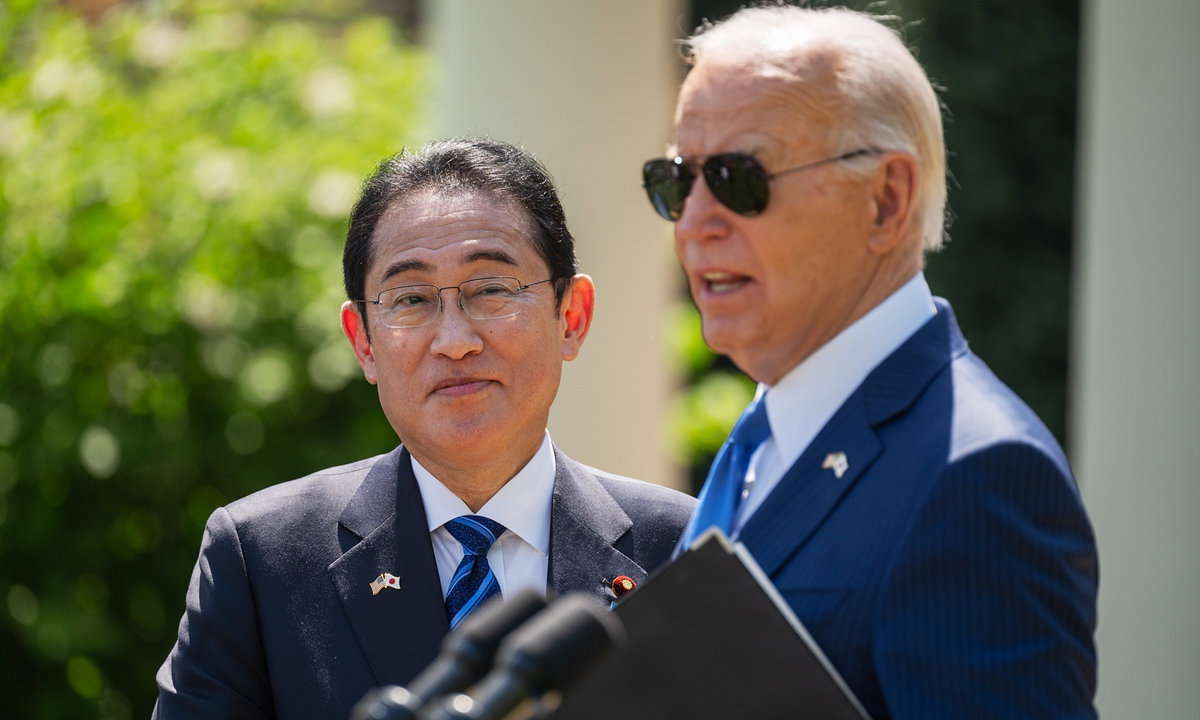
Photo: CFP
Japan has been making frequent, unusual moves recently. It joined the US and the Philippines for their first trilateral summit followed by a statement that devoted a whole paragraph to the South China Sea and gave a hint that Japan might join AUKUS soon. It is planning with the US to upgrade their security alliance to the largest extent since the two countries signed a mutual defense treaty in 1960. The Japanese government has also decided to revise the implementation guidelines of the Three Principles on Transfer of Defense Equipment and Technology, which will relax restrictions on arms export and seeking military breakthroughs.
Behind all these moves is the US eagerly helping to strengthen its junior partner's military capabilities as a way to contain its perceived rivals in the Asia-Pacific, namely China. Though well aware of the dangerous return of Japanese militarism, the US and Japanese authorities still decided to open a "Pandora's box" at the cost of regional and global peace, only to maintain US hegemony.
Japan's actions intensify tensions in the Asia-Pacific region
Japan's militarist past, marked by devastating wars of aggression and brutal crimes against humanity, brought untold suffering to its neighboring countries and beyond. Without ever really introspecting into its war crimes, Japan has on the contrary been increasing defense spending year after year, relaxing restrictions on arms exports and seeking military breakthroughs, including plans to buy Tomahawk cruise missiles from the US. According to a recent report by Asahi Shimbun, a regiment of Japan's Self-Defense Forces even used the term "Great East Asia War" in one of the posts on its official X account, which was once used by the Japanese government during World War II. It was such a dangerous move that some described it as an embodiment of the resurrection of Japan's Imperial Army.
Japan's right-wing forces are becoming active in many directions: in the East China Sea, it keeps trying to provoke China over the Diaoyu Islands; in the South China Sea, it is flexing its muscles along with the US to embolden the Philippines to look for troubles with China; and on the nuclear issue, it is talking about the possibility of nuclear sharing with America, trying to break away from the current nuclear umbrella provided by the US.
US fueling of flames will only backfire
Besides promoting its own interests, Japan has always been willing to serve as pawns of the US after the Cold War to maintain the latter's hegemony in the Asia-Pacific. It was also the intention of the US to loosen the shackles on Japan in order to maintain its supremacy in this region. No other country can work as a better outpost of the US to implement its "Asia-Pacific Strategy" hatched to contain and suppress China, as Japan has the willingness to antagonize its major neighbor, the military capability to assist US operations, and a long-standing alliance with the US that allows the latter to discipline Japan whenever needed. That leads to the US acquiescence, connivance and even encouragement toward Japan's right-wing forces' attempt to increase defense expenses, enhance security capabilities, and airbrush its wars of aggression, which has further fueled the arrogance of Japanese militarism. The latest example is the two parties' plan to enable seamless military integration of operations and capabilities, as well as explorations of advanced cooperation under AUKUS Pillar II.
Guided by its mindset of great power confrontation, the US is willing to let the monster of Japanese militarism resurface in the Asia-Pacific, which will gravely undermine peace and stability in this region. It has never been ashamed of sacrificing other countries' interests to maintain its own "position of strength," and this time China is not the only victim. ASEAN countries and the South Pacific islands will all suffer from the resurrection of the devil, as they experienced eight decades ago.
Will the US be immune from the damage caused by Japanese militarism? Hardly. Once a Pandora's box is opened, no one can escape the disasters released from it. Who knows where the next Pearl Harbor lies?
So, it is never as imperative and urgent as it is now that the US and Japanese authorities stop their rash move to bring Japanese militarism back from its grave and think about how to contribute to regional and global peace and security, rather than harm it.
The author is a commentator on international affairs, writing regularly for Xinhua News, Global Times, China Daily, CGTN etc. He can be reached at xinping604@gmail.com.
